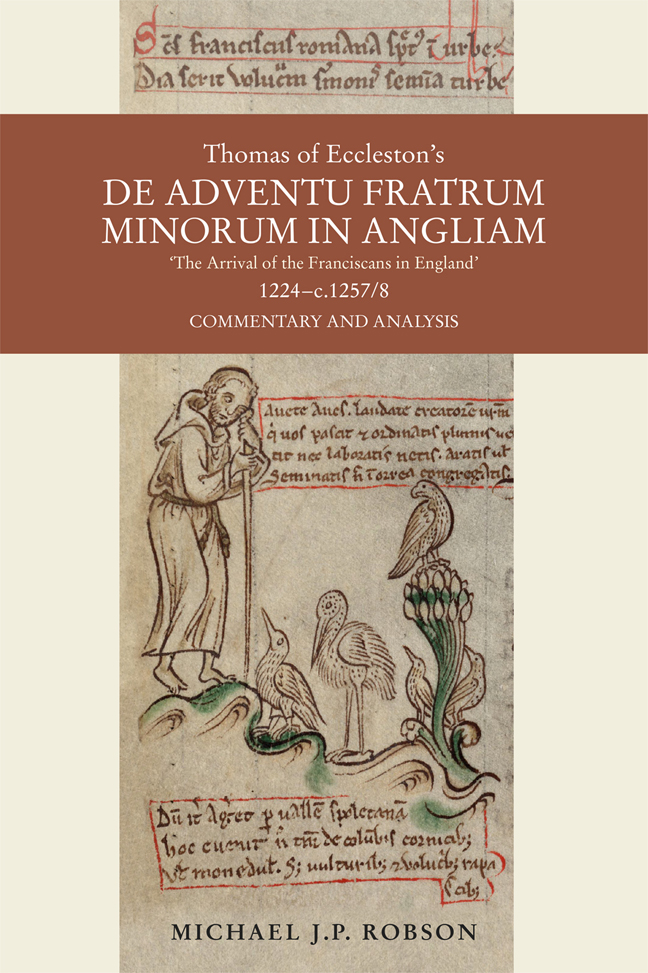Book contents
- Frontmatter
- Dedication
- Contents
- Acknowledgements
- List of Abbreviations
- Timeline
- Introduction
- 1 The launching of the mission to England
- 2 The first foundations
- 3 The admission of novices
- 4 The growth of the Franciscan community
- 5 The fervour of the early friars
- 6 The office of preaching
- 7 The seven custodies
- 8 The three general visitators
- 9 The Irish and Scottish provinces
- 10 The relocation of friaries and their enlargement
- 11 The friars’ schools of theology
- 12 The confessors
- 13 The ministers general
- 14 The ministers provincial
- 15 A gallery of friars
- A post script
- Bibliography
- Index
- Miscellaneous Endmatter
10 - The relocation of friaries and their enlargement
Published online by Cambridge University Press: 02 March 2024
- Frontmatter
- Dedication
- Contents
- Acknowledgements
- List of Abbreviations
- Timeline
- Introduction
- 1 The launching of the mission to England
- 2 The first foundations
- 3 The admission of novices
- 4 The growth of the Franciscan community
- 5 The fervour of the early friars
- 6 The office of preaching
- 7 The seven custodies
- 8 The three general visitators
- 9 The Irish and Scottish provinces
- 10 The relocation of friaries and their enlargement
- 11 The friars’ schools of theology
- 12 The confessors
- 13 The ministers general
- 14 The ministers provincial
- 15 A gallery of friars
- A post script
- Bibliography
- Index
- Miscellaneous Endmatter
Summary
Between 1235 and 1255 the English province was in transition. The initial premises occupied by the friars – ordinary dwellings – were no longer adequate to house the expanding number of friars. In one sense, they were the victims of their own success because they had drawn innumerable men and youths to the order. This daily increase in their number (crescente indies numero fratrum) generated questions of how best to accommodate them and organise their domestic lives. The criteria for the construction of friaries and churches moved imperceptibly to the top of the order’s agenda at provincial chapters. The writings of St Francis, especially his Testament, enshrined the principles to guide friars in executing their programmes of building friaries and churches. The multiple questions facing the order were also addressed in the hagiographical literature. The Compilatio Assisiensis, for example, sounded the warning against those who sought to justify building on a larger scale and moving from domestic chapels to small churches. Sometimes three successive churches were built on the same site. In other cases the friars relocated from the suburbs to the heart of the city, requiring the demolition of some domiciles and creating upheaval in their wake, a policy which jarred with the friars’ self-projected image. The polemical exchanges of the 1250s and 1270s frequently pointed to the cathedralesque churches erected by the friars. He argued that the friars’ churches were finer than cathedrals and their ornaments were more splendid than those of any prelate, apart from the pope; their bell-towers were very costly; they had double cloisters of great splendour in which armed knights could do battle with lances erect. St Paul’s cross was within earshot of the newly completed Greyfriars, with its spacious church and its second cloister. From the end of the 1220s the friars began to construct chapels. One prominent benefactor was Henry III who donated timber from the royal forests. Albert of Pisa was a reforming minister provincial and he took steps to reaffirm the principle of building in a modest manner. Before the end of this period external critics, professed themselves to be scandalised by the opulence of the order’s churches and conventual complexes.
Religious reformers and building
The question of how religious orders should build was a perennially challenging one.
- Type
- Chapter
- Information
- Thomas of Eccleston's De adventu Fratrum Minorum in Angliam 'The Arrival of the Franciscans in England', 1224-c. 1257/8Commentary and Analysis, pp. 176 - 190Publisher: Boydell & BrewerPrint publication year: 2023



